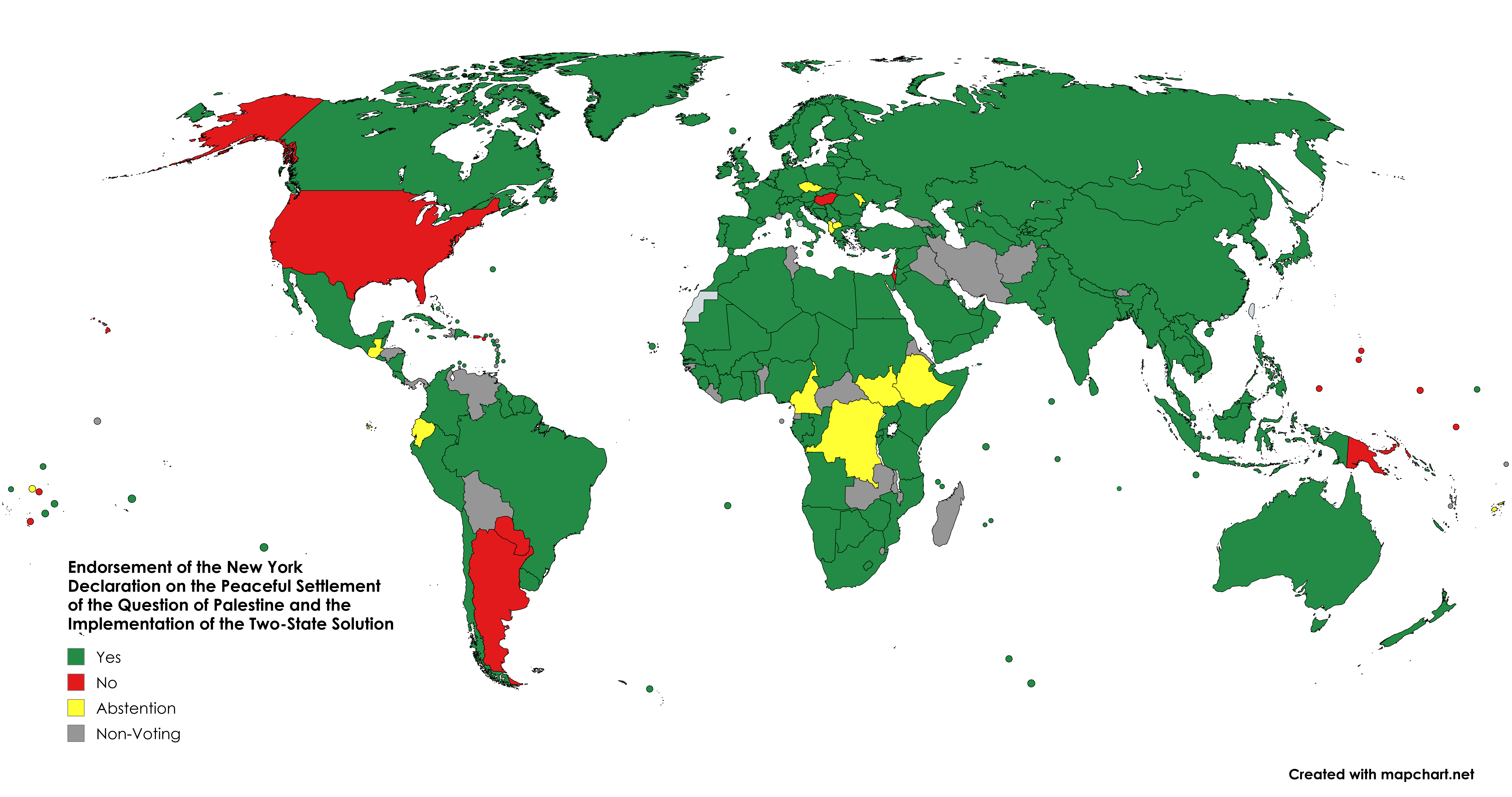UN Voting Map on New York Declaration Palestine


David Chen
Data Visualization Specialist
David Chen is an expert in transforming complex geographic datasets into compelling visual narratives. He combines his background in computer science ...
Geographic Analysis
What This Map Shows\nThis map visualizes the United Nations member states' voting patterns regarding the endorsement of the New York Declaration on the Peaceful Settlement of the Question of Palestine and the Implementation of the Two-State Solution. It highlights how different countries voted—whether in favor, against, or abstained—on this significant resolution. This vote underscores the international community's stance on a critical issue that has long been a source of conflict in the Middle East.
Deep Dive into the Two-State Solution\nThe Two-State Solution is a proposed framework for resolving the Israeli-Palestinian conflict by establishing two separate states for the two groups. This concept has gained significant traction over the years, with the idea being that Israel and Palestine could coexist peacefully as neighboring sovereign states. However, the path to achieving this has been fraught with challenges, including territorial disputes, security concerns, and differing political agendas.
Interestingly, the New York Declaration encapsulates the international community's support for this solution, aiming to address the longstanding grievances of the Palestinian people while respecting Israel's right to exist in peace. The endorsement of such declarations is crucial as they reflect the global consensus—or lack thereof—on this contentious issue.
What's fascinating is that the voting patterns shown on this map reveal the geopolitics at play. Countries that have historically had close ties with Israel may vote against Palestinian statehood initiatives, while those with strong ties to Arab nations or a commitment to human rights may support them. For instance, in recent votes, nations such as the United States have often opposed such resolutions, citing concerns over security and the need for direct negotiations between the parties involved.
Moreover, the map serves as a reminder of how international relations can shape regional dynamics. Countries in the Middle East often have vested interests in the outcome of the Palestinian question, leading to varied responses based on their political alliances, economic interests, and historical contexts. For example, nations like Egypt and Jordan, which have peace treaties with Israel, may find themselves in a delicate position balancing their national interests with regional solidarity towards Palestine.
Regional Analysis\nLooking at the map, we can discern distinct voting blocs among different regions. For instance, we often see a majority of African and Asian nations supporting the endorsement of the New York Declaration. This trend highlights a broader solidarity with the Palestinian cause, often rooted in shared historical experiences of colonialism and a desire for self-determination.
Conversely, Europe presents a mixed picture. While many EU member states have shown support for Palestinian statehood, there are significant divisions, with countries like Hungary and the Czech Republic aligning more closely with Israel. This divergence can often be traced back to historical ties, economic partnerships, and political ideologies that influence foreign policy decisions.
In the Americas, the voting patterns can be starkly divided. Latin American countries like Argentina and Brazil have been vocal supporters of Palestinian rights, while the United States typically aligns with Israel, reflecting a longstanding diplomatic relationship. This dichotomy illustrates how domestic politics and international relations can intersect, influencing how countries engage with the Palestinian question.
Significance and Impact\nUnderstanding voting patterns related to the New York Declaration is crucial for grasping the complexities of the Israeli-Palestinian conflict. The map not only highlights where support and opposition lie but also signals the broader implications for international relations and peace efforts. As global dynamics shift, the importance of these votes may evolve, but the underlying issues remain pressing.
The endorsement of the Two-State Solution remains a beacon of hope for many, yet its realization is contingent upon sustained diplomatic efforts and dialogue. Current trends indicate a growing recognition of the need for a peaceful resolution, but political will remains a significant barrier. As nations continue to navigate their foreign policies amid changing geopolitical landscapes, the outcomes of such votes will be pivotal in shaping the future of Palestine and Israel.
In conclusion, the map not only provides a snapshot of current international sentiment but also invites us to reflect on the complexities of diplomacy, national interests, and the quest for peace in a region that has experienced decades of conflict. Have you noticed how global politics can sway local conflicts? The implications of these voting patterns extend far beyond the immediate issue at hand, influencing global stability and human rights for generations to come.
Visualization Details
- Published
- September 12, 2025
- Views
- 100
Comments
Loading comments...